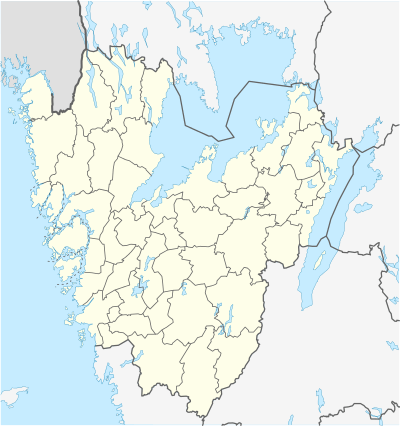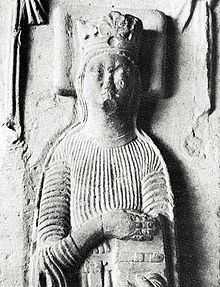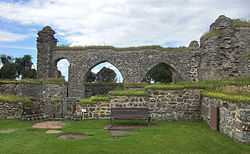Gudhem Abbey
|
Ruins of the monastery. | |
 Location within Västra Götaland | |
| Monastery information | |
|---|---|
| Order |
Order of Saint Benedict and Cistercians |
| Established | 1152 |
| Disestablished | 1527 |
| Site | |
| Location | Gudhem, Västra Götaland County, Sweden |
| Coordinates | 58°14′24″N 13°33′17″E / 58.24000°N 13.55472°ECoordinates: 58°14′24″N 13°33′17″E / 58.24000°N 13.55472°E |
Gudhem Abbey, Swedish Gudhems kloster, in operation from 1152 to 1529, was a nunnery in Sweden, initially Benedictine and later Cistercian. It was located in Gudhem outside Falköping in the Falbygden area in Västergötland. It is considered to have been one of the oldest convents in Sweden, after Vreta Abbey (1100) and Alvastra Abbey (1143).
History
Gudhem, a name signifying "Home of the Gods", was according to tradition a holy place of worship already before Christianity. According to the saga, one hundred images of the thunder god Thor was placed in Gudhem. According to a popular legend, Gudhem Abbey was founded in 1052 by Gunnhildr Sveinsdóttir, Queen Dowager of Sweden and Denmark, who returned to a life of penitence in her estate in Västergötland in Sweden, after her marriage with king Svein II of Denmark was annulled by the Church. In reality, however, the Abbey was founded exactly one hundred years later, in 1152. Charles VII of Sweden donated the royal estate of Gudhem Manor to the Abbey during his reign (1161-1167), and the nunnery was by then described as newly established.
Gudhem Abbey was a prestigious during the 13th century, when it was responsible for providing the Pilgrims of Nidaros with hospitality. The Swedish Queen Dowager Catherine of Ymseborg entered the abbey in the mid 13th century and donated her wast estates to it. During the reformation in 1527, the abbey was confiscated by the crown, and the year after, it was granted to the knight Nils Olofsson. The former nuns, however, were granted an allowance from the properties formerly belonging to the abbey and the right to live in the building for life. In 1529, the abbey caught fire and burned down. The last abbess asked the King to rebuilt the abbey, but her request was not granted, and the nuns was housed by the surrounding peasantry. They continued to be supported by the allowance granted them in 1527. There were still former nuns benefiting from the allowance living in the surroundings of the former abbey in 1540. The abbey was never rebuilt again, and the ruins were used as a quarry. In the late 17th century, the walls of the church was still in original height. The ruins was excavated in 1928-1969.
Gudhem Abbey is the inspiration of the nunnery in The Knight Templar (Crusades trilogy), were the character Cecelia is imprisoned.
Gallery
-

Gudhem Church
-

Ruins of the monastery.
-

The cellar to the monastery.
-

Tomb of Catherine of Ymseborg in Gudhem Abbey.
Sources
| Wikimedia Commons has media related to Gudhems kloster. |
- Famil-Journalen. Band 15. Årgång 1876
